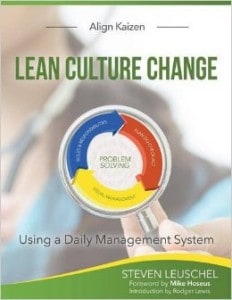
Mark's Note: Today's post is an excerpt, used with permission, from a new book by Steven Leuschel titled “Lean Culture Change,” with an introduction by Rodger Lewis, a former Toyota executive at the Georgetown, Kentucky plant. I've also recently recorded a podcast with Steven, which will be published in February.
I believe I first met Steven. a few years ago when I spoke at an event at the Kennametal Center for Operational Excellence in Pennsylvania. Steven is a Lean Coach and “Operational Excellence Coordinator” at Indiana Regional Medical Center (which is, also, in Pennsylvania, actually). In addition to this book, he has also written a few posts on LEI's “Lean Post” site.
 Excerpt from Chapter 2 of Lean Culture Change: Using a Daily Management System:
Excerpt from Chapter 2 of Lean Culture Change: Using a Daily Management System:
The Daily Huddle is a short, stand-up meeting that engages a team to make and sustain positive improvement through face-to-face communication. As a structured daily communication between team leader and team member, the huddle is conducted in front of a balanced scoreboard as a visual management tool to aid in more efficient and effective communication. The purpose of the huddle is to recognize outstanding behavior and positive improvements, to develop and understand problem-solving techniques, to check processes via leading indicators, and to communicate a proactive plan and expectations for the day. Aligned, tiered huddles serve as a standard for communication and a standard daily check throughout the organization.
Huddle Standards Within a Daily Management System
Huddle standards provide a framework and insight into the agenda, in order to keep the huddle consistent through the organization, but adapted to meet the desired culture of the unit. The goal is for all staff members to be involved in at least one huddle each day. Leaders may engage in one huddle with their team members and a second huddle with their leader. The recommended standards, which provide a quick reference for training team members on the purpose and expectations of the daily huddle, are as follows:
1. Same time, same place. It's important for the huddle to be held at the same time and the same place, in order to have predictability and begin to create a daily habit for all employees. Though there's never a perfect time, team leaders who have a “we'll get to it if there's time” mentality will struggle with sustainability and change because “there's never enough time” or “something else came up.” Having a consistent place is just as important, because the location of the huddle will build uniformity and predictability. Generally, when starting out, this standard is more important than trying to shift the time each day to accommodate everyone.
2. Everyone, every day. Not all staff will be able to attend each and every huddle due to the need to care for patients. Direct, hands-on patient care that needs to be completed as soon as possible always takes priority over the huddle. However, anything that can wait for 5 or 10 minutes, such as putting a non-urgent order into a computer, registering a routine patient, or making follow-up phone calls to a physician office, can wait. Being “too busy” with non-immediate and non-urgent concerns is not a valid excuse for missing any huddle for team leaders or members. In a busy environment, it's easy to find an excuse to miss the huddle; however, if deployed properly, team members will begin to appreciate the valid reasons why they must attend the huddle.
3. Follow the vitals and prompts. Create and update the daily huddle prompt sheet to encourage positive communication and discussion about improvements to problems. Managers will use these standards to coach team members and engage everyone into continuous improvement. Also, the priority order of the prompts is one way for an organization to put espoused values into practice (e.g., talking about safety before finance).
4. Stand at the balanced scoreboard. Whether the team is a frontline caregiver team, a team of unit managers, or a Senior Team, the standard is to stand at the balanced scoreboard, which is introduced in Chapter 5. Standing helps keep the meeting short and focused on problems, improvements, and visuals on the scoreboard. One study noted that sit-down meetings were 34% longer than stand-up meetings (Bluedorn et al, 1999, p. 277)
5. Short 5- to 15-minute meetings. Although the huddle is essential for positive and effective communication throughout the organization, it still takes caregivers away from direct patient care. Therefore, keeping the huddle efficient and effective is critical. If all the other standards are followed, keeping the meeting short should not be a problem. This does not mean to cut the huddle short once 5 minutes are up; it means to follow the standards and provide coaching to keep your huddles both efficient and effective.
6. Keep it positive. Continually share and communicate the positive improvements and stories that occur at both the unit and organization level. When coaching problem statements, coach to the facts and process-driven statements, not people-driven statements (i.e., pointing blame). Do not allow negative individuals to overpower the rest of the team. Immediately focus complaints towards the problem-solving process. Select prompts that will shine light on individuals at the huddle by sharing positive employee-patient service excellence stories and positive improvement stories.
7. Problem-solving sheet or improvement form for every problem or idea. Generally, if the problem or idea is important enough to report at a huddle, it's important enough to have a problem-solving sheet or improvement form as a means of communication and documentation. Writing it down will increase the chances of the problem being solved. In general, Senior Teams will focus on enforcing problem solving, while frontline pilot halls will first focus on generating ideas using the improvement system (explained in Chapter 7). Documentation of the problem or idea is critical, as it is the first step in both the problem-solving process and the improvement process.
8. No problem discussion. Once the sheet is started, do not dwell on the problem at a huddle or talk about potential causes of the problem. Encourage fact management and direct observation–neither of which can be done at the huddle. If this happens, the leader will ask staff members to work together to solve the problem outside of the huddle and report back at the next huddle to the team, using the problem-solving sheet or improvement system. Though teams may use the huddle time to discuss improvements or modify existing ideas for implementation, loose problem discussion is not acceptable.
9. Follow up and communicate. Communication is critical. When there is an update to a problem-solving sheet or improvement in process, communicate often. Communicate with team members so they know and understand the problem-solving process, where the problem-sheets are going, and what the expectations are based on the organization's maturity with problem solving. As improvements are being piloted, implemented, and documented, the employee who owns the improvement will keep the team updated on status and impact. (This is discussed more in Chapter 7, Improvement System.)
10. Proactive daily outlook. Use the huddle as a way to communicate the outlook and plan for the day–for example, communicating the number of patients in the Emergency Department, the day's census, planned vendor visits for the day, needed changes to Operating Room schedule, etc. Creating visual management tools to help manage the day and support the huddle will be implemented on a case-by-case basis.
Thanks to Steven for sharing the excerpt. I hope you'll check out his book Lean Culture Change: Using a Daily Management System.
What questions do you have for him about huddles? What experiences and stories do you have to share about using huddles and, hopefully, using them to help drive and manage Kaizen, or daily continuous improvement in healthcare or other settings?
What do you think? Please scroll down (or click) to post a comment. Or please share the post with your thoughts on LinkedIn – and follow me or connect with me there.
Did you like this post? Make sure you don't miss a post or podcast — Subscribe to get notified about posts via email daily or weekly.
Check out my latest book, The Mistakes That Make Us: Cultivating a Culture of Learning and Innovation:









Well done Steve. As we continue to use tiered huddles at IRMC, problem solving and improvement ideas have been sparked throughout the organization resulting in many, many improvements. Thanks for your leadership! Mark N.
[…] You might remember a post from January that included an excerpt from his book on “huddles.” […]